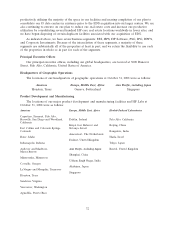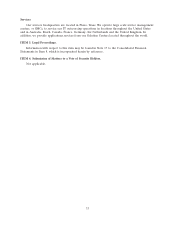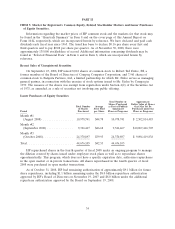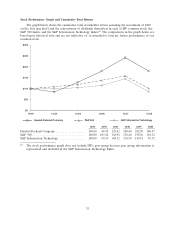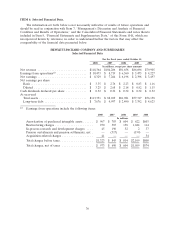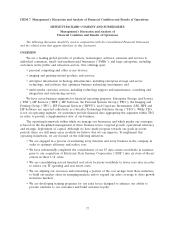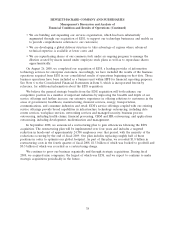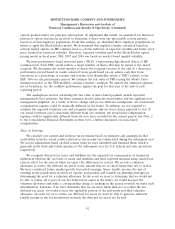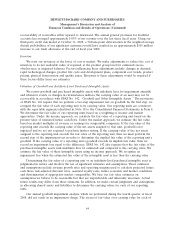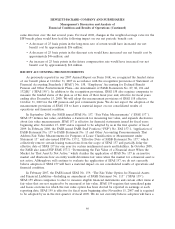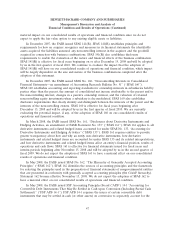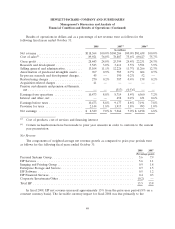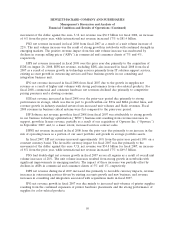HP 2008 Annual Report Download - page 47
Download and view the complete annual report
Please find page 47 of the 2008 HP annual report below. You can navigate through the pages in the report by either clicking on the pages listed below, or by using the keyword search tool below to find specific information within the annual report.HEWLETT-PACKARD COMPANY AND SUBSIDIARIES
Management’s Discussion and Analysis of
Financial Condition and Results of Operations (Continued)
Business Combinations
We allocate the purchase price of acquired companies to the tangible assets acquired, liabilities
assumed and intangible assets acquired, including in-process research and development (‘‘IPR&D’’),
based on their estimated fair values. The excess of the purchase price over these fair values is recorded
as goodwill. We engage independent third-party appraisal firms to assist us in determining the fair
values of assets acquired and liabilities assumed. Such valuations require management to make
significant estimates and assumptions, especially with respect to intangible assets. The significant
purchased intangible assets recorded by HP include customer contracts, developed and core technology
and the Compaq trade name. The fair values assigned to the identified intangible assets are discussed
in detail in Note 7 to the Consolidated Financial Statements in Item 8.
Critical estimates in valuing certain intangible assets include but are not limited to: future expected
cash flows from customer contracts, customer lists, distribution agreements, and acquired developed
technologies and patents; expected costs to develop IPR&D into commercially viable products and
estimating cash flows from projects when completed; Compaq brand awareness and market position, as
well as assumptions about the period of time the brand will continue to be used in HP’s product
portfolio; and discount rates. Management’s estimates of fair value are based upon assumptions
believed to be reasonable, but which are inherently uncertain and unpredictable and, as a result, actual
results may differ from estimates.
Other estimates associated with the accounting for acquisitions may change as additional
information becomes available regarding the assets acquired and liabilities assumed, as more fully
discussed in Note 6 to the Consolidated Financial Statements in Item 8.
Restructuring
We have engaged, and may continue to engage, in restructuring actions, which require
management to utilize significant estimates related to expenses for severance and other employee
separation costs, realizable values of assets made redundant or obsolete, lease cancellation and other
exit costs. If the actual amounts differ from our estimates, the amount of the restructuring charges
could be materially impacted. For a full description of our restructuring actions, refer to our discussions
of restructuring in the Results of Operations section and Note 8 to the Consolidated Financial
Statements in Item 8, which are incorporated herein by reference.
Stock-Based Compensation Expense
We recognize stock-based compensation expense for all share-based payment awards granted after
November 1, 2005 and granted prior to but not yet vested as of November 1, 2005, in accordance with
SFAS No. 123 (revised 2004) ‘‘Share-Based Payment’’ (‘‘SFAS 123R’’). Under the fair value recognition
provisions of SFAS 123R, we recognize stock-based compensation expense net of an estimated
forfeiture rate, recognizing compensation cost for only those shares expected to vest on a straight-line
basis over the requisite service period of the award. Prior to SFAS 123R adoption, we accounted for
share-based payment awards under Accounting Principles Board Opinion No. 25, ‘‘Accounting for Stock
Issued to Employees’’ (‘‘APB 25’’) and, accordingly, generally recognized compensation expense only
when we granted options with a discounted exercise price.
Determining the appropriate fair value model and calculating the fair value of share-based
payment awards require subjective assumptions, including the expected life of the share-based payment
awards and stock price volatility. We utilize the Black-Scholes option pricing model to value the stock
41



